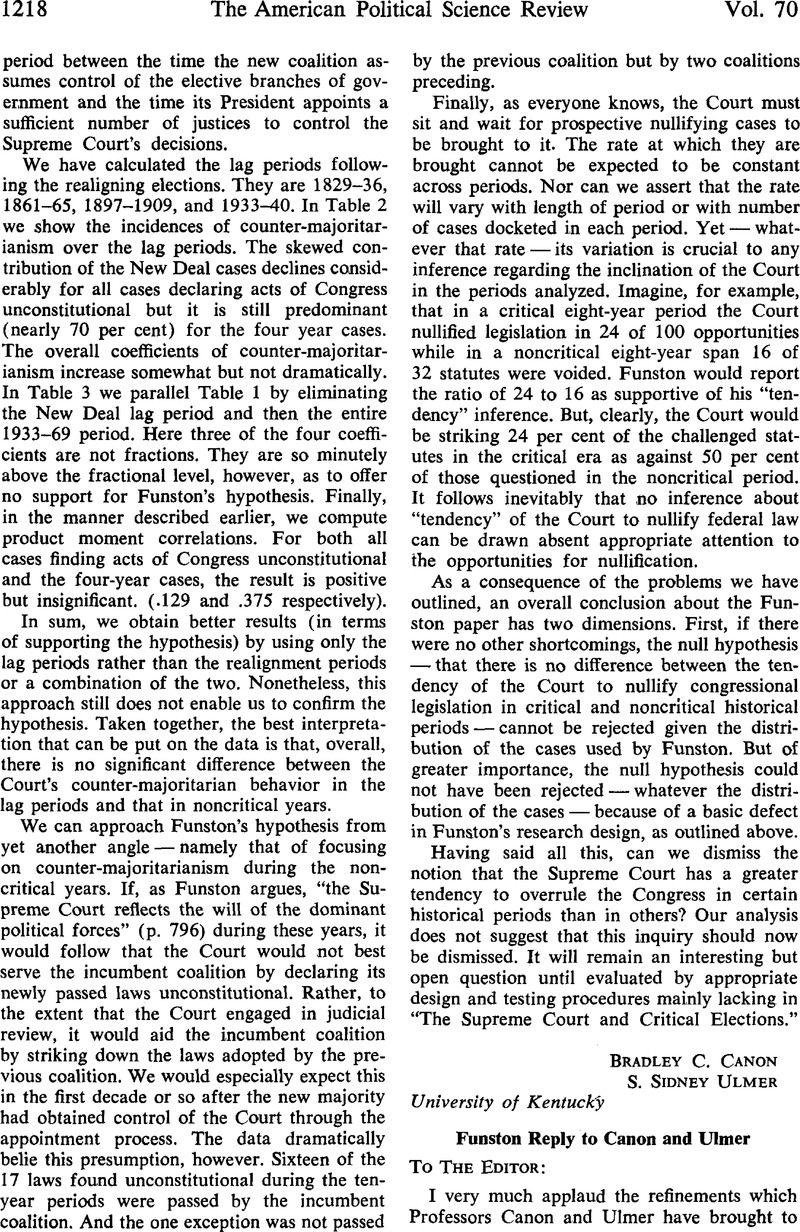Published online by Cambridge University Press: 01 August 2014

page 1219 note 1 I accepted Dahl's and Burnham's evidence and assumptions for purposes of replication. But the work of both has recently been subjected to serious criticism. Casper, Jonathan D., “The Supreme Court and National Policy Making,” American Political Science Review, 70 (March, 1976), 50–63CrossRefGoogle Scholar; James, Dorothy Buckton, Book Review, Political Science Quarterly, 91 (Spring, 1976), 147–148CrossRefGoogle Scholar. It is far too facile, however, for me simply to observe that Professors Canon's and Ulmer's quarrel lies with others than myself. I shall, therefore, attempt to respond to the more important of their specific objections.
page 1219 note 2 Dahl, Robert, “Decision-Making in a Democracy: The Supreme Court as a National Policy-Maker,” Journal of Public Law, 6 (Fall, 1957), 279–295, 287 n. 11Google Scholar.
page 1219 note 3 Pritchett, C. Herman, The American Constitution, 2nd edition (New York: McGraw-Hill, 1968), p. 166Google Scholar, and The Constitution of the United States of America, Sen. Doc. no. 39, 88th Cong., 1st sess. (Washington, D.C.: U.S. Gov't Printing Office, 1964), pp. 1387–1402Google Scholar, report that sixty-five laws were voided by 1937. On the other hand, Professor Abraham identifies seventy-six; Abraham, Henry, The Judicial Process, 3rd edition (New York: Oxford, 1975), pp. 288–291Google Scholar. Even for more recent decisions there is no agreement; thus, Professor Casper states that for the period 1958–74 there have been 28 instances of the exercise of the power of judicial review, while Professor Dionisopoulos counts thirty-two. Casper, , “The Supreme Court and National Policy Making,” pp. 53–54Google Scholar; Dionisopoulos, Allan, “Judicial Control of Congress,” (paper, Department of Political Science, Northern Illinois University, 1976)Google Scholar.
page 1219 note 4 395 U.S. at 36.
page 1219 note 5 395 U.S. at 274 (Harlan, J., dissenting).
page 1220 note 6 Neither did Casper, “The Supreme Court and National Policy Making,” include O'Callahan as an example of the exercise of the power of judicial review.
page 1220 note 7 See also Casper, , “The Supreme Court and National Policy Making,” p. 56Google Scholar.
page 1220 note 8 Adamany, David, “Legitimacy, Realigning Elections, and the Supreme Court,” Wisconsin Law Review (September, 1973), pp. 790–846Google Scholar.
page 1220 note 9 Goldman, Sheldon and Jahnige, Thomas P., The Federal Courts as a Political System (New York: Harper & Row, 1971), pp. 261–268Google Scholar; Nagel, Stuart S., The Legal Process from a Behavioral Perspective (Homewood, Ill.: Dorsey, 1969), pp. 245–279Google Scholar.
page 1220 note 10 E.g., Mendelson, Wallace, “Judicial Review and Party Politics,” Vanderbilt Law Review, 12 (March, 1959), 447–457Google Scholar; Roche, John, Courts and Rights (New York: Random House, 1961), pp. 22–24, 46Google Scholar.
page 1220 note 11 Adamany, , “Legitimacy, Realigning Elections, and the Supreme Court,” p. 824Google Scholar.
Comments
No Comments have been published for this article.